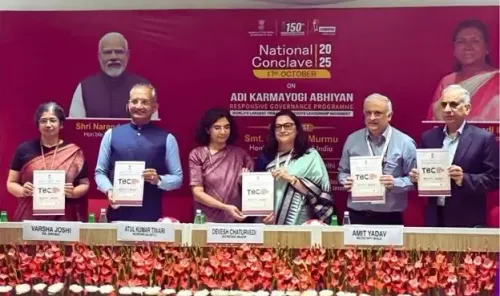How Will GST Reforms Propel Ladakh's Economy?

Synopsis
Key Takeaways
- The GST reduction enhances affordability for local crafts.
- Pashmina exports from Changthang region are expected to rise.
- Traditional handicrafts like Namda rugs will see a revival.
- Tourism in Ladakh will become more accessible.
- Women-led groups producing sea buckthorn products will benefit.
New Delhi, Oct 22 (NationPress) The recent reforms in Goods and Services Tax (GST) are poised to lower expenses and expand opportunities for artisans, farmers, and tourism operators in Ladakh, while also preserving traditional crafts, as stated by the government on Wednesday.
The reduction in rates from 12 percent to 5 percent is expected to improve the affordability and competitiveness of genuine Pashmina, handwoven woollen products, Thangka paintings, and items made from apricots and sea buckthorn, according to an official announcement.
This decrease in GST could significantly boost the export of Pashmina wool from the Changthang region, supporting the livelihoods of over 10,000 nomadic herders. Furthermore, this reform is anticipated to enhance the market position of authentic Ladakhi pashmina against imported or machine-manufactured options.
Production costs for handwoven woollens and Namda rugs in Leh and Kargil are also expected to decline, fostering a revival of traditional handicraft techniques.
The reduction in GST from 12 percent to 5 percent on hotel tariffs for accommodations up to Rs 7,500 per night will make travel and lodging more budget-friendly, especially during peak tourism periods. This is likely to further stimulate eco-tourism and the local homestay sector.
Traditional Ladakhi carpentry and Thangka paintings produced in monasteries will gain from improved price competitiveness. These Thangka paintings from monasteries in Leh, Alchi, and Hemis are classic Buddhist scroll artworks used for meditation and aesthetic purposes.
The GST reforms will also support over 6,000 farming families involved in apricot farming and processing by enhancing the marketability of local apricots and their value-added products, including dried apricots, jams, and oils. Ladakh is recognized as India’s largest apricot producer, with Kargil, Leh, and the Nubra Valley being the primary production areas.
Moreover, these reforms will strengthen the markets for sea buckthorn products, predominantly produced by women-led self-help groups. Other products benefiting from the GST reforms include yak cheese, Leh berry health drinks, supplements, and organic agricultural products.









